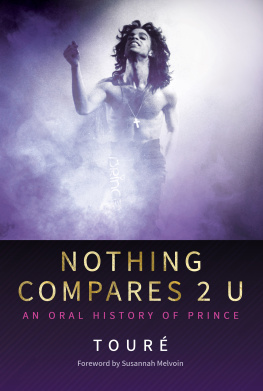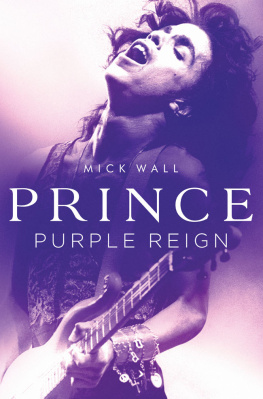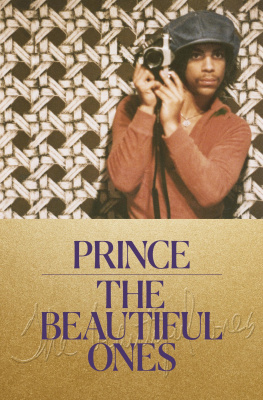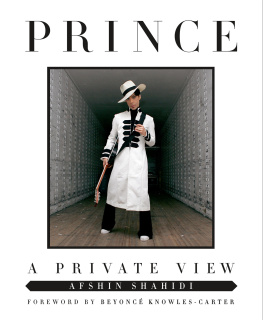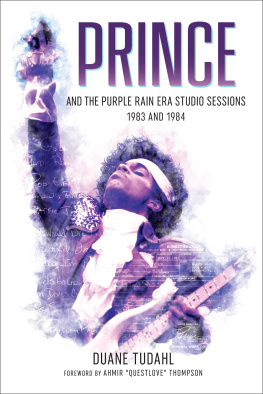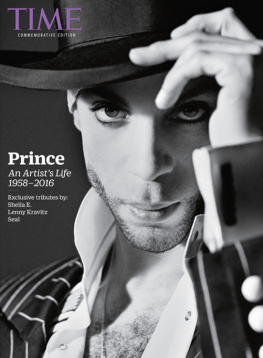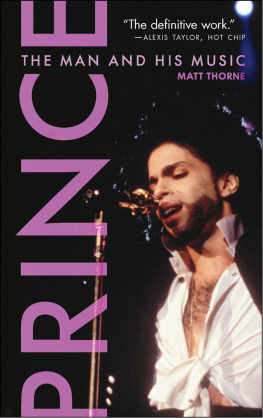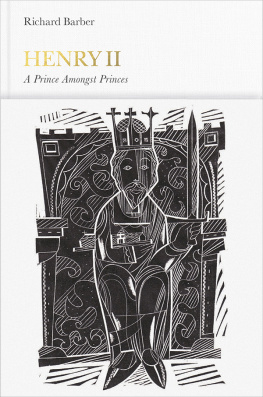All rights reserved, including the right to reproduce this book or any portion thereof by any means
All rights reserved. No part of this publication may be reproduced or used in any form or by any means- graphic, electronic, or mechanical, including photocopying, recording, taping, or information storage and retrieval systems-without written permission of the publisher.
How many bands around the world played Purple Rain or another Prince song on or near April 21, 2016, in settings ranging from arenas to dive bars? Chances are it was thousands.
On April 23, Bruce Springsteen performed a passionate and faithful version of Purple Rain. Pearl Jam followed suit. Then, Jimmy Buffett. At the Coachella music festival on April 23, the idiosyncratic folk artist Sufjan Stevens performed yet another Purple Rain. The same night at the festival, perhaps doing Prince the greatest justice, the techno outfit LCD Soundsystem ripped through a pained, pulsating rendition of Controversy.
Every musician in the world, it seemed, wanted to say goodbye.
I learned of Princes death at about 1:30 p.m. while writing in a coffee shop in Cambridge, Massachusetts. It was my 50th birthday. The artist who had most defined my adult life was gone. The term living legacy, long applicable to Princes work, was now legacy only.
But what a legacy it was.
Princes death, and the worldwide outpouring of emotion that followed, underscored the enormity of his accomplishments as a songwriter, instrumentalist, performer, and cultural figure. Perhaps not since the death of John Lennon had we lost a musician of such influence and impact.
How to choose the domain where Princes footprint was the largest? As a performer in the concert setting, where his skills, commitment, and energy never flagged across a nearly 40-year career? As the creator of an album and rock film, Purple Rain , whose impact rivals any such effort in music history? As a multi-instrumentalist who riffed with equal mastery on guitar, synthesizer, piano, drums, and bass? As the composer of innumerable pop hits that have not only stood the test of time, but long ago became timeless?
As fans and observers, we all have our own answer. And they are all correct.
The Beatles forever redefined the use of melody in pop and rock. Jimi Hendrixs inimitable guitar work redefined the instrument. But just as importantly, Prince created a hybrid style that began to redefine pop music immediately upon its arrival. He blended multiple constituent elements the funk of James Brown, the synths and drum machines of New Wave, the melody of Top 40 pop, the energy of hard rock, and even the angst of punk in a manner no pop artist had remotely conceived of. By no more than 90 seconds into Controversy perhaps the first definitive expression of Princes vision a new direction for popular music had been set.
The influence of that sound would reverberate through the subsequent decades and beyond, permeating countless subgenres of music. That Prince altered the trajectory of music in the late 20 th century is not in doubt. But well into the 21 st , not just a portion, but rather a preponderance of contemporary artists continue to owe him a direct debt.
That any of this occurred was hardly preordained. Michael Jackson, by contrast, had a pedigree and inherited apparatus that promised a shot at stardom. The Beatles were bestowed with such melodic ability that their impact seemed divinely prefigured. Princes path was different, and never remotely as obvious. Nothing was ever guaranteed to a shy black kid from Minneapolis, a skinny motherfucker with a high voice and a huge Afro. He succeeded because his talent, as bountiful as it was, was exceeded by his work ethic and ceaseless energy.
But if no one had ever achieved superstardom in the same manner, Prince left a roadmap that seemingly anyone could follow. Get a multi-track machine and start laying down ideas; form a band that includes girls and boys, blacks and whites, straights and gays. Have the men dress like women, and vice versa. Welcome everyone, and allow anything.
But Prince also taught us this: when making musical recordings, you can, and probably should, go it alone. Be a complete auteur , and insist upon executing your vision without any intermediary between yourself and the recording console. Like a poet or novelist, you must embrace the solitary life.
Prince never wavered from these core precepts, and it is unlikely that any musician in the history of recorded sound has spent so many hours alone playing and writing. The takeaway for aspiring musicians is apparent: there is no need to be dependent on anyone.
***
Of course, there are aspects of Princes legacy that ultimately must be wrestled with, rather than unapologetically celebrated. Specifically, there is the conundrum of his recordings from roughly 1989 through 2016, which have engendered endless debate about whether, or to what extent, Prince returned to the form that characterized his strongest work. Of course, Prince had erected for himself (and others) an impossible standard; his output from 1980-1988 constitutes one of the most prolific runs of brilliance in the history of pop music, one that rivals the heydays of the Beatles, the Rolling Stones, and Bob Dylan.
Few would disagree that Princes efforts became less consistent from 1989-2003, and that the sheer volume of his output became at times overwhelming. But he nonetheless released plenty of indelible songs during that period, as well as several albums, such as The Gold Experience (1995) and Emancipation (1996) that were remarkably consistent and coherent.
Likewise, Princes recorded output from 2004 to 2016 has spawned considerable debate, and he himself stoked this controversy by releasing material in a puzzling manner, such as via the sprawling three-album set LotusFlow3r (2009), which was initially available as a physical CD solely in the United States, and there only in Target stores. But in hindsight, one can more easily discern that the first disc of that collection features musicianship that is an extraordinary combination of looseness, discipline, and ingenuity. And it is also poignantly clear that Prince had brilliant music left in him, as shown, for example, by the cuts Way Back Home, June, and Black Muse from his final three albums, songs that some see as ranking with his strongest work.
Ultimately, the notion that Princes career at some point entered into a steady downward trend is not only unsuited to the moment, but also frankly not accurate. For example, Princes live performances during the past 15 years demonstrated that in this area, he remained an ascending talent, not one in decline.
Indeed, Prince played some of the most memorable concerts of his career in the last months of his life. These shows featured him alone at a piano, performing songs from across his canon and astonishing attendees with the expressiveness of his playing. Casual and hardcore fans alike were often literally brought to tears by renditions of Purple Rain, Condition of the Heart, and Strange Relationship. That the shows took place in venues such as the Sydney Opera House underscored the once-in-a-lifetime quality of the events.


